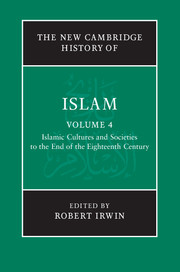Book contents
- Frontmatter
- Introduction
- PART I RELIGION AND LAW
- PART II SOCIETIES, POLITICS AND ECONOMICS
- PART III LITERATURE
- PART IV LEARNING, ARTS AND CULTURE
- 20 Education
- 21 Philosophy
- 22 The sciences in Islamic societies (750–1800)
- 23 Occult sciences and medicine
- 24 Literary and oral cultures
- 25 Islamic art and architecture
- 26 Music
- 27 Cookery
- Glossary
- Bibliography
- Index
- References
25 - Islamic art and architecture
from PART IV - LEARNING, ARTS AND CULTURE
Published online by Cambridge University Press: 28 March 2011
- Frontmatter
- Introduction
- PART I RELIGION AND LAW
- PART II SOCIETIES, POLITICS AND ECONOMICS
- PART III LITERATURE
- PART IV LEARNING, ARTS AND CULTURE
- 20 Education
- 21 Philosophy
- 22 The sciences in Islamic societies (750–1800)
- 23 Occult sciences and medicine
- 24 Literary and oral cultures
- 25 Islamic art and architecture
- 26 Music
- 27 Cookery
- Glossary
- Bibliography
- Index
- References
Summary
This chapter presents an introduction to the art and architecture of the Islamic world from the first/seventh century through to the end of the twelfth/eighteenth. This is an exceptionally rich visual culture that encompasses the portable artefacts and buildings produced in a region comprising Spain, North and sub-Saharan Africa, Sicily, Eastern and Central Europe, the Middle East, Central Asia, the Indian subcontinent and South-East Asia. Islamic art is renowned for its achievements in calligraphy and complex forms of geometric and vegetal ornament, but it also boasts a vigorous and inventive tradition of figurative painting. It is important to recognise from the outset that the distinctions made in traditional scholarship of Western European visual culture between ‘high art’ (usually defined as architecture, painting and sculpture) and ‘craft’ cannot be applied to an Islamic context. In order to evaluate the main lines of development in Islamic art it is necessary to consider media including pottery, metalwork, glass, textiles, mosaics, stucco, stone, ivory and wood. Nor is it simply a matter of the sheer variety of media and techniques; frequently the craftsmen involved in the manufacture of seemingly humble media such as glazed ceramics, carved and moulded stucco or base metal vessels worked at the forefront of significant phases of artistic creativity. Islamic architecture is equally diverse in character; masons and allied craftsmen adapted to local building traditions, and made innovative use of brick, stone, wood, glazed tile, plaster and other materials in the construction and decoration of both religious and secular structures.
- Type
- Chapter
- Information
- The New Cambridge History of Islam , pp. 682 - 742Publisher: Cambridge University PressPrint publication year: 2010



